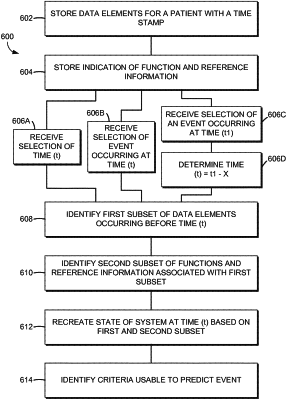| CPC G06Q 10/06 (2013.01) [G16H 10/20 (2018.01); G16H 10/40 (2018.01); G16H 20/10 (2018.01)] | 20 Claims |

|
1. Non-transitory computer-readable media having computer-executable instructions embodied thereon that, when executed, perform a method for recreating a state of a clinical computing system for indicating that a specific activity corresponding to a patient increased prior to a chronic event, the method comprising:
extracting a first set of data elements from electronic records associated with the patient occurring at or before the chronic event from the clinical computing system, wherein the first set of data elements represents one of a clinical document, a lab value, a medication, a problem list, or a clinical order;
extracting a second set of data elements from the electronic records associated with the patient from the clinical computing system that were available in the clinical computing system prior to the chronic event, the second set of data elements represents one of the clinical document, the lab value, the medication, the problem list, or the clinical order;
wherein the first set of data elements and the second set of data elements are extracted in electronic form and stored in memory of the clinical computing system;
identifying a first state change for each data element in the first set of data elements;
identifying a second state change for each data element in the second set of data elements;
recreating the state of the clinical computing system that is prior to the chronic event by concatenating the first set of data elements and the second set of data elements based on the first state change and the second state change for each respective data element; and
communicating for display on a computer interface a recreated state of the clinical computing system that is prior to the chronic event, wherein the recreated state from the concatenated first set of data elements and the second set of data elements indicating that the specific activity corresponding to the patient increased over a predetermined activity level prior to the chronic event to predict an occurrence of the chronic event.
|